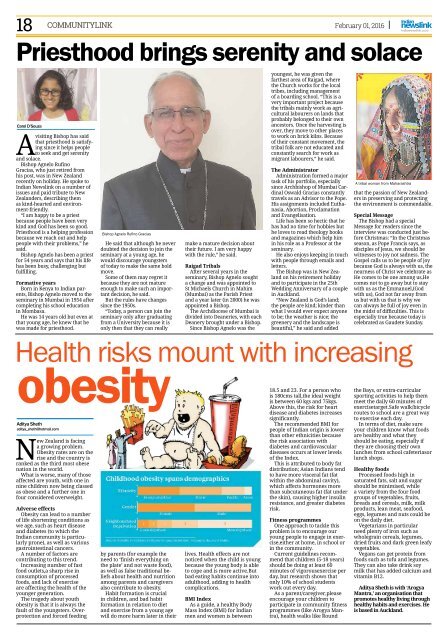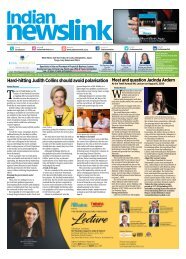Create successful ePaper yourself
Turn your PDF publications into a flip-book with our unique Google optimized e-Paper software.
18<br />
COMMUNITYLINK<br />
February 01, 2016<br />
Priesthood brings serenity and solace<br />
Carol D’Souza<br />
A<br />
visiting Bishop has said<br />
that priesthood is satisfying<br />
since it helps people<br />
to seek and get serenity<br />
and solace.<br />
Bishop Agnelo Rufino<br />
Gracias, who just retired from<br />
his post, was in New Zealand<br />
recently on holiday. He spoke to<br />
Indian Newslink on a number of<br />
issues and paid tribute to New<br />
Zealanders, describing them<br />
as kind-hearted and environment-friendly.<br />
“I am happy to be a priest<br />
because people have been very<br />
kind and God has been so good.<br />
Priesthood is a helping profession<br />
because we reach out and help<br />
people with their problems,” he<br />
said.<br />
Bishop Agnelo has been a priest<br />
for 54 years and says that his life<br />
has been busy, challenging but<br />
fulfilling.<br />
Formative years<br />
Born in Kenya to Indian parents,<br />
Bishop Agnelo moved to the<br />
seminary in Mumbai in 1954 after<br />
completing his school education<br />
in Mombasa.<br />
He was 14 years old but even at<br />
that young age, he knew that he<br />
was made for priesthood.<br />
Bishop Agnelo Rufino Gracias<br />
He said that although he never<br />
doubted the decision to join the<br />
seminary at a young age, he<br />
would discourage youngsters<br />
of today to make the same bold<br />
move.<br />
Some of them may regret it<br />
because they are not mature<br />
enough to make such an important<br />
decision, he said.<br />
But the rules have changes<br />
since the 1950s.<br />
“Today, a person can join the<br />
seminary only after graduating<br />
from a University because it is<br />
only then that they can really<br />
make a mature decision about<br />
their future. I am very happy<br />
with the rule,” he said.<br />
Raigad Tribals<br />
After several years in the<br />
seminary, Bishop Agnelo sought<br />
a change and was appointed to<br />
St Michaels Church in Mahim<br />
(Mumbai) as the Parish Priest<br />
and a year later (in 2000) he was<br />
appointed a Bishop.<br />
The Archdiocese of Mumbai is<br />
divided into Deaneries, with each<br />
Deanery brought under a Bishop.<br />
Since Bishop Agnelo was the<br />
youngest, he was given the<br />
farthest area of Raigad, where<br />
the Church works for the local<br />
tribes, including management<br />
of a boarding school. “This is a<br />
very important project because<br />
the tribals mainly work as agricultural<br />
labourers on lands that<br />
probably belonged to their own<br />
ancestors. Once the harvesting is<br />
over, they move to other places<br />
to work on brick kilns. Because<br />
of their constant movement, the<br />
tribal folk are not educated and<br />
constantly search for work as<br />
migrant labourers,” he said.<br />
The Administrator<br />
Administration formed a major<br />
task of his portfolio, especially<br />
since Archbishop of Mumbai Cardinal<br />
Oswald Gracias constantly<br />
travels as an Advisor to the Pope.<br />
His assignments included Euthanasia,<br />
Abortion, Proclamation<br />
and Evangelisation.<br />
Life has been so hectic that he<br />
has had no time for hobbies but<br />
he loves to read theology books<br />
and magazines which help him<br />
in his role as a Professor at the<br />
seminary.<br />
He also enjoys keeping in touch<br />
with people through emails and<br />
letters.<br />
The Bishop was in New Zealand<br />
on his retirement holiday<br />
and to participate in the 25th<br />
Wedding Anniversary of a couple<br />
in Auckland.<br />
“New Zealand is God’s land;<br />
the people are kind; kinder than<br />
what I would ever expect anyone<br />
to be; the weather is nice; the<br />
greenery and the landscape is<br />
beautiful,” he said and added<br />
A tribal woman from Maharashtra<br />
that the passion of New Zealanders<br />
in preserving and protecting<br />
the environment is commendable.<br />
Special Message<br />
The Bishop had a special<br />
Message for readers since the<br />
interview was conducted just before<br />
Christmas: “In the Christmas<br />
season, as Pope Francis says, as<br />
disciples of Jesus, we should be<br />
witnesses to joy not sadness. The<br />
Gospel calls us to be people of joy<br />
because God is always with us, the<br />
nearness of Christ we celebrate as<br />
He comes to be one among us,He<br />
comes not to go away but to stay<br />
with us as the Emmanuel,(God<br />
with us), God not far away from<br />
us but with us that is why we<br />
can always be full of joy even in<br />
the midst of difficulties. This is<br />
especially true because today is<br />
celebrated as Gaudete Sunday.<br />
Health risks mount with increasing<br />
obesity<br />
Aditya Sheth<br />
aditya_sheth@hotmail.com<br />
New Zealand is facing<br />
a growing problem.<br />
Obesity rates are on the<br />
rise and the country is<br />
ranked as the third most obese<br />
nation in the world.<br />
What is worse, many of those<br />
affected are youth, with one in<br />
nine children now being classed<br />
as obese and a further one in<br />
four considered overweight.<br />
Adverse effects<br />
Obesity can lead to a number<br />
of life shortening conditions as<br />
we age, such as heart disease<br />
and diabetes (to which the<br />
Indian community is particularly<br />
prone), as well as various<br />
gastrointestinal cancers.<br />
A number of factors are<br />
contributing to this trend.<br />
Increasing number of fast<br />
food outlets,a sharp rise in<br />
consumption of processed<br />
foods, and lack of exercise<br />
are affecting the health of the<br />
younger generation.<br />
The tragedy about youth<br />
obesity is that it is always the<br />
fault of the youngsters. Overprotection<br />
and forced feeding<br />
by parents (for example the<br />
need to ‘finish everything on<br />
the plate’ and not waste food),<br />
as well as false traditional beliefs<br />
about health and nutrition<br />
among parents and caregivers<br />
also contribute to obesity.<br />
Habit formation is crucial<br />
in children, and bad habit<br />
formation in relation to diet<br />
and exercise from a young age<br />
will do more harm later in their<br />
lives. Health effects are not<br />
noticed when the child is young<br />
because the young body is able<br />
to cope and is more active.But<br />
bad eating habits continue into<br />
adulthood, adding to health<br />
complications.<br />
BMI Index<br />
As a guide, a healthy Body<br />
Mass Index (BMI) for Indian<br />
men and women is between<br />
18.5 and 23. For a person who<br />
is 180cms tall,the ideal weight<br />
is between 60 kgs and 75kgs.<br />
Above this, the risk for heart<br />
disease and diabetes increases<br />
significantly.<br />
The recommended BMI for<br />
people of Indian origin is lower<br />
than other ethnicities because<br />
the risk association with<br />
diabetes and cardiovascular<br />
diseases occurs at lower levels<br />
of the Index.<br />
This is attributed to body fat<br />
distribution; Asian Indians tend<br />
to have more visceral fat (fat<br />
within the abdominal cavity),<br />
which affects hormones more<br />
than subcutaneous fat (fat under<br />
the skin), causing higher insulin<br />
resistance, and greater diabetes<br />
risk.<br />
Fitness programmes<br />
One approach to tackle this<br />
problem is to encourage our<br />
young people to engage in exercise,either<br />
at home, in school or<br />
in the community.<br />
Current guidelines recommend<br />
that children (5-18 years)<br />
should be doing at least 60<br />
minutes of vigorousexercise per<br />
day, but research shows that<br />
only 10% of school students<br />
work out every day.<br />
As a parent/caregiver,please<br />
encourage your children to<br />
participate in community fitness<br />
programmes (like Arogya Mantra),<br />
health walks like Round<br />
the Bays, or extra-curricular<br />
sporting activities to help them<br />
meet the daily 60 minutes of<br />
exercisetarget.Safe walk/bicycle<br />
routes to school are a great way<br />
to exercise each day.<br />
In terms of diet, make sure<br />
your children know what foods<br />
are healthy and what they<br />
should be eating, especially if<br />
they are choosing their own<br />
lunches from school cafeteriasor<br />
lunch shops.<br />
Healthy foods<br />
Processed foods high in<br />
saturated fats, salt and sugar<br />
should be minimised, while<br />
a variety from the four food<br />
groups of vegetables, fruits,<br />
breads and cereals, milk, milk<br />
products, lean meat, seafood,<br />
eggs, legumes and nuts could be<br />
on the daily diet.<br />
Vegetarians in particular<br />
need plenty of iron such as<br />
wholegrain cereals, legumes,<br />
dried fruits and dark green leafy<br />
vegetables.<br />
Vegans can get protein from<br />
foods such as tofu and legumes.<br />
They can also take drink soy<br />
milk that has added calcium and<br />
vitamin B12.<br />
Aditya Sheth is with ‘Arogya<br />
Mantra,’ an organisation that<br />
promotes healthy living through<br />
healthy habits and exercises. He<br />
is based in Auckland.


















